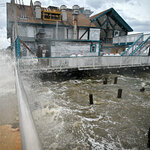Kyllä Iranissa nyt betonikauppa käy, kun valavat paksumpia kattoja bunkkereihin. Taitaa olla turhaa hommaa.Kohteet on varmasti tiedossa eikä khamenei ole niistä vähäisin. Uskoisin että Israel odottaa tilaisuutta ja eliminoi khamenein lähikuukausina.
Miten Iranilaiset itse tilanteen näkevät, olisi ihan mielenkiintoista tietää. Haluaisivatko rauhaa ja sujuvia kansainvälisiä suhteita vai haluavatko oikeasti tuhota taloutensa ja tulevaisuutensa laajamittaisessa sodassa.
Install the app
How to install the app on iOS
Follow along with the video below to see how to install our site as a web app on your home screen.
Note: This feature may not be available in some browsers.
You are using an out of date browser. It may not display this or other websites correctly.
You should upgrade or use an alternative browser.
You should upgrade or use an alternative browser.
Liekkö noissa ollut edes räjähteitä sisällä? Sen verran pieni kuoppakin tullut.Tuhojen laajuutta miettiessä osumakohta merkkaa paljon. Tässä osuttu sinänsä keskeiselle paikalle, mutta isoin energia on mennyt vain kuopan tekoon
Iranilainen bunkkeripommi
Kohtuullinen juttu (huhtikuulta) Israelin kaukovaikutuskyvystä ja Iranin kyvystä torjua sitten.
Israelin ballistinen ohjelma on tiukan salainen tämän mukaan.

 news.sky.com
news.sky.com
Israelin ballistinen ohjelma on tiukan salainen tämän mukaan.

What missiles could Israel use in an attack - and can Iran defend itself?
Sky News looks at how Israel might attack, and how Iran could respond.
Liekkö noissa ollut edes räjähteitä sisällä? Sen verran pieni kuoppakin tullut.
Liitteet
Israelilla ei ole muuta vaihtoehtoa, kun vastata niin kovaa, että isommat yrittämisen halut loppuu... Yrittäjiä kyllä riittää, jos ei heti vastata ja kovaa... Ukrainassa vähän sama tilanne... Kumpa maailman päättäjät tämän tajuaisivat ja vastaus olisi tarpeeksi kova, että se maailmanrauhaa vastaan toimiva uho loppuisi yhdeltä ja toiselta sotahullulta jo lähtökuoppiin... Koska tämä ihmiskunta mitään oppii? Minäkin melko pitkään tätä katellut ja mikään ei ole muuttunut ainakaan parempaan päin...isreal on tähän mennessä vastannut sitä vastaan kohdistuneihin iskuihin aika rankalla kädellä ja johtoportaan lausunnot iskuista on ollut aika mahtipontisia, kostoa ja tuhoa on vannovia. eli jos vanhaa kaavaa noudatetaan hallitus vannoo kostoa ja kaiken terrorismin kytkemistä ja sitä he tulee myös yrittämään kovaa.
Tallahassee
Kersantti
Vaikuttaa pahasti siltä että Teheran-Joen hallinto on taas sopinut Iranin kanssa että saavat tehdä sen ensi-iskun (jota vastaan USA auttaa) ja sitten Teheran-Joen hallinto painostaa Israelin olemaan vastaamatta (ja USA ei auta jos Israel iskee Iraniin ja USA tunnustaa Hamastanin).
Täytyy toivoa ettei Israel alistu tähän kiristykseen. Tai ehkä luottavat Trumpin valintaan, että voivat hoitaa homman loppuun silloin. Huono juttu jokatapauksessa jos Israel ei vastaa nyt.
Täytyy toivoa ettei Israel alistu tähän kiristykseen. Tai ehkä luottavat Trumpin valintaan, että voivat hoitaa homman loppuun silloin. Huono juttu jokatapauksessa jos Israel ei vastaa nyt.
lsoviha
Eversti
Iranin vallankumouskaarti kertoo laukaisseensa kymmeniä ohjuksia Israeliin
Vallankumouskaartin mukaan kyseessä on kostotoimi Hamas-johtaja Ismail Haniyehin, Hizbollah-johtaja Hassan Nasrallahin sekä Iranin vallankumouskaartin apulaiskomentaja Abbas Nilforoushanin surmista.
Vallankumouskaarti uhkaa Israelia uudella hyökkäyksellä, mikäli se kostaa tiistain iskut. (Lähde: Reuters)
----
Tuskin mitään isompaa tapahtuu lähipäivinä tai viikkoina. 6kk sitten iran lähetti saman määrän risteileviä ja suristimia jotka torjuttiin minimaalisin vahingoin. Mitään suoraa vastausta ei tapahtunut toki viimeaikaisessa hezbollahin puhdistuksessa saatiin iranilaisia kylmäksi.
Vallankumouskaartin mukaan kyseessä on kostotoimi Hamas-johtaja Ismail Haniyehin, Hizbollah-johtaja Hassan Nasrallahin sekä Iranin vallankumouskaartin apulaiskomentaja Abbas Nilforoushanin surmista.
Vallankumouskaarti uhkaa Israelia uudella hyökkäyksellä, mikäli se kostaa tiistain iskut. (Lähde: Reuters)
----
Tuskin mitään isompaa tapahtuu lähipäivinä tai viikkoina. 6kk sitten iran lähetti saman määrän risteileviä ja suristimia jotka torjuttiin minimaalisin vahingoin. Mitään suoraa vastausta ei tapahtunut toki viimeaikaisessa hezbollahin puhdistuksessa saatiin iranilaisia kylmäksi.
se on selvää että israel iskee kovaa, jännä nähdä miten maailma reagoi tähän koska tuki isrealille on ollut vähän ristiriitaista tähän mennessä. tottakai israelia tuetaan mutta se että onko se vain humaanista ja rauhaan tähtäävää diplomaattisin keinoin, vai annetaanko isrealille lupa iskeä kovaa sotilaallisesti.Israelilla ei ole muuta vaihtoehtoa, kun vastata niin kovaa, että isommat yrittämisen halut loppuu... Yrittäjiä kyllä riittää, jos ei heti vastata ja kovaa... Ukrainassa vähän sama tilanne... Kumpa maailman päättäjät tämän tajuaisivat ja vastaus olisi tarpeeksi kova, että se maailmanrauhaa vastaan toimiva uho loppuisi yhdeltä ja toiselta sotahullulta jo lähtökuoppiin... Koska tämä ihmiskunta mitään oppii? Minäkin melko pitkään tätä katellut ja mikään ei ole muuttunut ainakaan parempaan päin...
videoiden perusteella aika moni ohjus pääsi maahan asti räjähtämään, ehkä lähipäivinä saadaan tietää todelliset tuhot.Iranin vallankumouskaarti kertoo laukaisseensa kymmeniä ohjuksia Israeliin
Vallankumouskaartin mukaan kyseessä on kostotoimi Hamas-johtaja Ismail Haniyehin, Hizbollah-johtaja Hassan Nasrallahin sekä Iranin vallankumouskaartin apulaiskomentaja Abbas Nilforoushanin surmista.
Vallankumouskaarti uhkaa Israelia uudella hyökkäyksellä, mikäli se kostaa tiistain iskut. (Lähde: Reuters)
----
Tuskin mitään isompaa tapahtuu lähipäivinä tai viikkoina. 6kk sitten iran lähetti saman määrän risteileviä ja suristimia jotka torjuttiin minimaalisin vahingoin. Mitään suoraa vastausta ei tapahtunut toki viimeaikaisessa hezbollahin puhdistuksessa saatiin iranilaisia kylmäksi.
Ehkä paras taktiikka ei olekaan vastata suoraan, kun ei olla eliminoimassa ainakaan kovin suurta välitöntä uhkaa?Toivottavasti jossain vaiheessa laitetaa F-35 laivasto liikkeelle ja Iranin ilmavoimat ja muutama asevarasto katoaa savuna ilmaan. Sinänsä sääli Tomcatteja, mutta ehkä Maverick käy yhden kaappaamassa ennen tuhoa.
Odottavan aika on pitkä, hermoja raastavaa jatkuvaa varuillaoloa, ja odotus saattaa avata parempia paikkoja iskeä, kun jossain vaiheessa aletaan olla huolimattomia ja sijainnit paljastua jne?
Itelle tuli niistä semmoinen olo, että ei tainnut olla räjähteitä mukana niissä ohjuksissa. Ainoastaan polttoaine paloi. Niin moni ohjus osui maahan ilman suurempaa räjähdystä. Siis jos vertaa Ukrainaan.videoiden perusteella aika moni ohjus pääsi maahan asti räjähtämään, ehkä lähipäivinä saadaan tietää todelliset tuhot.
Pihkakoski
Ylipäällikkö
tottakai mahdollista mutta kyllä videoissa kuului ihan kunnon räjähdykset ja tuntuu jotenkin tyhmältä laukasta kymmeniä ellei jopa sata ohjusta vihollis valtioon ilman räjähdettä ihan vain muuten vaan. luulis iraninkin tarkoituksena ollut aiheuttaa paljon tuhoa eikä tuhlata kalliita ohjuksia.Itelle tuli niistä semmoinen olo, että ei tainnut olla räjähteitä mukana niissä ohjuksissa. Ainoastaan polttoaine paloi. Niin moni ohjus osui maahan ilman suurempaa räjähdystä. Siis jos vertaa Ukrainaan.
On mielenkiintoista kuulla mitä ohjuksia iskussa on tosiaan käytettyItelle tuli niistä semmoinen olo, että ei tainnut olla räjähteitä mukana niissä ohjuksissa. Ainoastaan polttoaine paloi. Niin moni ohjus osui maahan ilman suurempaa räjähdystä. Siis jos vertaa Ukrainaan.
Liittolaiset auttaa
x.com
Viimeksi muokattu:
Tuossa jotain.
Pihkakoski
Ylipäällikkö
NYT:in artikkeli, jossa kerrotaan että puolet Hizbollahin ase-arsenaalista on tuhottu Israelin iskuissa.
Listen to this article · 7:54 min Learn more

Smoke rising from buildings in Beirut after a series of Israeli airstrikes last week.Credit...Diego Ibarra Sanchez for The New York Times



By Edward WongJulian E. Barnes and Eric Schmitt
Reporting from Washington
Oct. 1, 2024, 2:43 p.m. ET
Want to stay updated on what’s happening in Israel and Lebanon? Sign up for Your Places: Global Update, and we’ll send our latest coverage to your inbox.
Israel’s recent airstrikes in Lebanon destroyed about half of the missiles and rockets that Hezbollah had accumulated over more than three decades, dealing a blow to the militia’s capabilities, according to senior Israeli and American officials.
But the group’s arsenal remains formidable, with tens of thousands of projectiles across the country, and large barrages could overwhelm Israel’s “Iron Dome” anti-projectile defense system, the officials said.
Hezbollah scattered its weapons across Lebanon — the country is “peppered” with them, one Israeli official said — and has been using them since last October to fire mainly into northern Israel.
Israel had been making strikes in southern Lebanon, forcing tens of thousands of Lebanese to flee. But Israeli leaders decided around Sept. 17 to destroy as much of the arsenal as possible, so that the 60,000 or so Israelis who had fled northern Israel because of the persistent fire could return, two Israeli officials said. The Israeli Air Force began devastating strikes the next week.
Hezbollah, with help from Iran, took three decades to build up most of its stockpile, estimated to be anywhere from 120,000 to 200,000 projectiles. After the initial attacks, Hassan Nasrallah, the leader of Hezbollah, asked Iran and Syria to replenish the arsenal, the Israeli officials and an American official said. That contributed to Israel’s decision to try to kill Mr. Nasrallah.
Since Mr. Nasrallah’s killing last Friday, Lebanese officials have heeded Israel’s demands to turn away Iranian planes trying to fly into Beirut, complicating Hezbollah’s effort to get additional arms quickly, American officials say.
On Tuesday, the Israeli military said it had killed the Hezbollah commander in charge of arms transfers from Iran to Lebanon, Muhammad Jaafar Qasir, in an airstrike in Beirut.
U.S. officials say Hezbollah’s attacks on northern Israel, which began the day after Hamas carried out its devastating Oct. 7 assault in southern Israel, were an answer to Israel’s war in Gaza. They said that Hezbollah might have stopped if Prime Minister Benjamin Netanyahu of Israel and Yahya Sinwar, the leader of Hamas, had agreed to a cease-fire.
But the United States, Qatar and Egypt have failed to get a Gaza cease-fire agreement in place after many rounds of diplomacy this year.



On Monday, Israel began ground operations in Lebanon. Officials said Israeli troops plan to destroy Hezbollah missile caches and launch vehicles.
The two Israeli officials say they intend to continue targeting Hezbollah’s arsenal and killing the group’s commanders while they have momentum. White House officials have said they hope the ground incursion is limited, and President Biden has made calls for a cease-fire from both sides. Hundreds of Lebanese civilians have been killed in Israeli strikes, and one million have been displaced.
“We are determined to return our residents in the north to their homes safely,” Mr. Netanyahu said on Tuesday.
Despite the sizable arsenal of missiles and rockets that Hezbollah still maintains, its fighters have not fired a huge number into central Israel.
Oct. 1, 2024, 1:34 p.m. ET1 hour ago
American officials say one reason is that a series of Israeli attacks, culminating last Friday in the airstrike that killed Mr. Nasrallah outside Beirut, have severely damaged the group’s command-and-control structure, leaving few senior people to give orders to lower-level fighters.
The group could also be waiting for a signal from Iranian officials, who had helped build up the arsenal as a deterrent against any possible Israeli assault on Iran, officials say. If Hezbollah uses up most of the rest of its arsenal and is not able to replenish it, that deterrent disappears.
And Hezbollah might prefer for Iran itself to retaliate, with its much more potent arsenal. In April, Iran fired more than 300 drones and missiles at Israel in retaliation for a deadly attack on an Iranian diplomatic compound in Syria. Israel, the United States and partner nations in the region shot down almost all of those.
On Tuesday night in the Middle East, the Iranian military fired ballistic missiles at Israel. Air raid sirens sounded across the country, and residents saw defensive interceptor missiles flying through the skies. Iran’s mission to the United Nations said on social media that the attack was in response to “terrorist acts” by Israel that had violated Iran’s “sovereignty.”
Some Israeli and American officials said they thought Israel had successfully established deterrence with Iran through a strike that Israel carried out after that April barrage from Iran. In the follow-up assault, Israel damaged one or more S-300 antiaircraft batteries that the Iranian military had placed around the ancient city of Isfahan, American officials said.
Such a strike, coupled with the Israeli assassination in July of Ismail Haniyeh, the political leader of Hamas, while he was in Tehran for a state funeral, showed that Israel could attack in the heart of Iran — and possibly kill Iranian leaders.
Some American officials stress that the top ranks of Hezbollah have been crippled by the sudden Israeli campaign. Its leadership has been decimated, not just by the killing of Mr. Nasrallah, but also by the pager explosions and other attacks that killed and injured top and midlevel leaders over the last three weeks.
The entire special operations command of Hezbollah, known as the Radwan Force, was wiped out in the Sept. 20 airstrike that killed Ibrahim Aqeel, effectively Hezbollah’s chief of military operations, in a southern suburb of Beirut, American officials say.
On Monday, Naim Qassem, the acting leader of Hezbollah after Mr. Nasrallah’s death, said contingency plans had been in place to ensure alternate commanders could step up if anything happened to the group’s leaders.
The heaviest recent wave of Israeli airstrikes hit 1,300 targets on Sept. 23, including sites with long-range cruise missiles, heavy rockets and drones, said Daniel Hagari, an Israeli military spokesman.
Still, American officials say it is an open question if Israel’s operations can be turned into a strategic gain. How long Israel remains in southern Lebanon, how deeply Iran engages in counterattacks, what Hezbollah does to respond and what political forces seize influence in Beirut will all be a factor in the long-term outcome.
Israel carried out a violent and failed occupation of Lebanon from 1982 to 2000, one that gave birth to Hezbollah.
Some American officials view the situation, particularly over the long term, with skepticism. They do not believe a military campaign in Lebanon can set back Hezbollah for long.
The group has a tunnel infrastructure that is impossible to destroy absent a long-term presence in the country, which Israeli officials say they are reluctant to reoccupy. The tunnels are dug deep into the rock under southern Lebanon and are difficult to hit with airstrikes. Parts of the network are big enough for large military equipment to move through.
These more pessimistic American officials say that even if Mr. Nasrallah was a singular and charismatic leader, the midlevel and even senior military commanders will be more easily replaced.
While Mr. Nasrallah appeared to have become wary about ordering big attacks on Israel after the widespread destruction in the 2006 Israel-Lebanon war, a new leader might not have the same sense of caution.
Euan Ward contributed reporting from Beirut.
Israel Has Destroyed Half of Hezbollah’s Arsenal, U.S. and Israeli Officials Say
The Lebanese militia is seeking more weapons from Iran, the officials said. It has yet to fire large barrages at Israel, and its top ranks have been crippled by Israeli strikes.Listen to this article · 7:54 min Learn more
- Share full article

Smoke rising from buildings in Beirut after a series of Israeli airstrikes last week.Credit...Diego Ibarra Sanchez for The New York Times



By Edward WongJulian E. Barnes and Eric Schmitt
Reporting from Washington
Oct. 1, 2024, 2:43 p.m. ET
Want to stay updated on what’s happening in Israel and Lebanon? Sign up for Your Places: Global Update, and we’ll send our latest coverage to your inbox.
Israel’s recent airstrikes in Lebanon destroyed about half of the missiles and rockets that Hezbollah had accumulated over more than three decades, dealing a blow to the militia’s capabilities, according to senior Israeli and American officials.
But the group’s arsenal remains formidable, with tens of thousands of projectiles across the country, and large barrages could overwhelm Israel’s “Iron Dome” anti-projectile defense system, the officials said.
Hezbollah scattered its weapons across Lebanon — the country is “peppered” with them, one Israeli official said — and has been using them since last October to fire mainly into northern Israel.
Israel had been making strikes in southern Lebanon, forcing tens of thousands of Lebanese to flee. But Israeli leaders decided around Sept. 17 to destroy as much of the arsenal as possible, so that the 60,000 or so Israelis who had fled northern Israel because of the persistent fire could return, two Israeli officials said. The Israeli Air Force began devastating strikes the next week.
Hezbollah, with help from Iran, took three decades to build up most of its stockpile, estimated to be anywhere from 120,000 to 200,000 projectiles. After the initial attacks, Hassan Nasrallah, the leader of Hezbollah, asked Iran and Syria to replenish the arsenal, the Israeli officials and an American official said. That contributed to Israel’s decision to try to kill Mr. Nasrallah.
Since Mr. Nasrallah’s killing last Friday, Lebanese officials have heeded Israel’s demands to turn away Iranian planes trying to fly into Beirut, complicating Hezbollah’s effort to get additional arms quickly, American officials say.
On Tuesday, the Israeli military said it had killed the Hezbollah commander in charge of arms transfers from Iran to Lebanon, Muhammad Jaafar Qasir, in an airstrike in Beirut.
U.S. officials say Hezbollah’s attacks on northern Israel, which began the day after Hamas carried out its devastating Oct. 7 assault in southern Israel, were an answer to Israel’s war in Gaza. They said that Hezbollah might have stopped if Prime Minister Benjamin Netanyahu of Israel and Yahya Sinwar, the leader of Hamas, had agreed to a cease-fire.
But the United States, Qatar and Egypt have failed to get a Gaza cease-fire agreement in place after many rounds of diplomacy this year.
Editors’ Picks

The Truth About Tuna

Why Do So Many Women Wear Giant Eyeglasses?

The Novelist Who Foresaw the ‘Big One’ for Florida’s Gulf Coast
On Monday, Israel began ground operations in Lebanon. Officials said Israeli troops plan to destroy Hezbollah missile caches and launch vehicles.
The two Israeli officials say they intend to continue targeting Hezbollah’s arsenal and killing the group’s commanders while they have momentum. White House officials have said they hope the ground incursion is limited, and President Biden has made calls for a cease-fire from both sides. Hundreds of Lebanese civilians have been killed in Israeli strikes, and one million have been displaced.
“We are determined to return our residents in the north to their homes safely,” Mr. Netanyahu said on Tuesday.
Despite the sizable arsenal of missiles and rockets that Hezbollah still maintains, its fighters have not fired a huge number into central Israel.
Middle East Crisis: Live Updates
UpdatedOct. 1, 2024, 1:34 p.m. ET1 hour ago
- Israel’s response to Iran’s missile barrage may determine the course of the war.
- Six killed and several injured in a shooting in Tel Aviv.
- Iran is poised to launch an attack on Israel, U.S. and Israeli officials say.
American officials say one reason is that a series of Israeli attacks, culminating last Friday in the airstrike that killed Mr. Nasrallah outside Beirut, have severely damaged the group’s command-and-control structure, leaving few senior people to give orders to lower-level fighters.
The group could also be waiting for a signal from Iranian officials, who had helped build up the arsenal as a deterrent against any possible Israeli assault on Iran, officials say. If Hezbollah uses up most of the rest of its arsenal and is not able to replenish it, that deterrent disappears.
And Hezbollah might prefer for Iran itself to retaliate, with its much more potent arsenal. In April, Iran fired more than 300 drones and missiles at Israel in retaliation for a deadly attack on an Iranian diplomatic compound in Syria. Israel, the United States and partner nations in the region shot down almost all of those.
On Tuesday night in the Middle East, the Iranian military fired ballistic missiles at Israel. Air raid sirens sounded across the country, and residents saw defensive interceptor missiles flying through the skies. Iran’s mission to the United Nations said on social media that the attack was in response to “terrorist acts” by Israel that had violated Iran’s “sovereignty.”
Some Israeli and American officials said they thought Israel had successfully established deterrence with Iran through a strike that Israel carried out after that April barrage from Iran. In the follow-up assault, Israel damaged one or more S-300 antiaircraft batteries that the Iranian military had placed around the ancient city of Isfahan, American officials said.
Such a strike, coupled with the Israeli assassination in July of Ismail Haniyeh, the political leader of Hamas, while he was in Tehran for a state funeral, showed that Israel could attack in the heart of Iran — and possibly kill Iranian leaders.
Some American officials stress that the top ranks of Hezbollah have been crippled by the sudden Israeli campaign. Its leadership has been decimated, not just by the killing of Mr. Nasrallah, but also by the pager explosions and other attacks that killed and injured top and midlevel leaders over the last three weeks.
The entire special operations command of Hezbollah, known as the Radwan Force, was wiped out in the Sept. 20 airstrike that killed Ibrahim Aqeel, effectively Hezbollah’s chief of military operations, in a southern suburb of Beirut, American officials say.
On Monday, Naim Qassem, the acting leader of Hezbollah after Mr. Nasrallah’s death, said contingency plans had been in place to ensure alternate commanders could step up if anything happened to the group’s leaders.
The heaviest recent wave of Israeli airstrikes hit 1,300 targets on Sept. 23, including sites with long-range cruise missiles, heavy rockets and drones, said Daniel Hagari, an Israeli military spokesman.
Still, American officials say it is an open question if Israel’s operations can be turned into a strategic gain. How long Israel remains in southern Lebanon, how deeply Iran engages in counterattacks, what Hezbollah does to respond and what political forces seize influence in Beirut will all be a factor in the long-term outcome.
Israel carried out a violent and failed occupation of Lebanon from 1982 to 2000, one that gave birth to Hezbollah.
Some American officials view the situation, particularly over the long term, with skepticism. They do not believe a military campaign in Lebanon can set back Hezbollah for long.
The group has a tunnel infrastructure that is impossible to destroy absent a long-term presence in the country, which Israeli officials say they are reluctant to reoccupy. The tunnels are dug deep into the rock under southern Lebanon and are difficult to hit with airstrikes. Parts of the network are big enough for large military equipment to move through.
These more pessimistic American officials say that even if Mr. Nasrallah was a singular and charismatic leader, the midlevel and even senior military commanders will be more easily replaced.
While Mr. Nasrallah appeared to have become wary about ordering big attacks on Israel after the widespread destruction in the 2006 Israel-Lebanon war, a new leader might not have the same sense of caution.
Euan Ward contributed reporting from Beirut.
ajs178
Respected Leader
Tehokkainta olisi sanoa, että Israel vastaa hyökkäykseen valitsemanaan aikana ja antaa ajatollahin hikoilla. Sitten yksi kerrallaan johtoporras 72 neitsyen luo kaikessa hiljaisuudessaEiköhän tuo tule, mutta yksittäisinä iskuina, joissa lähtee kaikki tekijät Khameneitä myöten.
Israelilla vain on sellainen pieni paine takana että heidän vastaiskun on oltava merkittävä ja onnistunut. Tähän saakka Israel on onnistunut loistavasti ja uskon että vastaus suunnitellaan niin hyvin että koko maailma näkee heidän sotilaallisen mahdin ja osaamisen.
Vaihtoehtoja on mielestäni kaksi, joko Ali kahjomieli likvitoidaan tai sitten isketään tarkasti ja lujaa sotilaallisiin kohteisiin (merivoimiin, sotilaslentokentille, asetehtaisiin sekä mahdollisiin ydinlaitoksiin). Toivoisin että vähintäänkin kaikki ryssän käyttöön aseita tuottavat laitokset lanataan kaikki sileäksi.
Mahtavin statement olisi toki Khamenein poisto jollain kirurgisella operaatiolla.
Vaihtoehtoja on mielestäni kaksi, joko Ali kahjomieli likvitoidaan tai sitten isketään tarkasti ja lujaa sotilaallisiin kohteisiin (merivoimiin, sotilaslentokentille, asetehtaisiin sekä mahdollisiin ydinlaitoksiin). Toivoisin että vähintäänkin kaikki ryssän käyttöön aseita tuottavat laitokset lanataan kaikki sileäksi.
Mahtavin statement olisi toki Khamenein poisto jollain kirurgisella operaatiolla.


